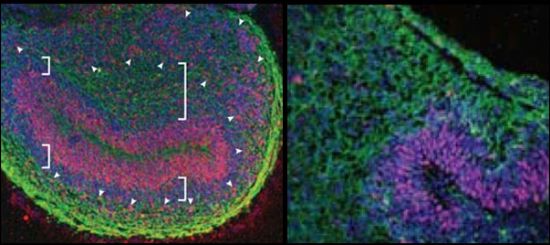by Larry
November, 2015A Lot of Little Gray MatterThese cultured tissues include portions of "cerebral organoid" structures normally present in our brains, with differentiated cells that if able to fully develop would become retinas, the cortex, and the hippocampus. These are probably the most highly developed or human-like lab-grown bits of gray matter ever generated. In some ways researchers using these cultured creations are close to having complete human embryo brains available for study. The brainy organoids have up to 98% of the cells found in a human embryo at five weeks. Yet they lack the sensory input or vascular systems necessary to grow into ordinarily functioning brains.
Already there have been significant findings from this kind of research. A patient with microcephaly, a disabling condition in which the brain that forms is substantially undersized, contributed some skin stem cells which were used in the development of a cerebral organoid. Scientists were able to determine how the growth of the brain was altered from normal at two stages, leading to this phenomenon. Other mini-brain researches have aided understandings of how specific drugs may be developed and used to suppress dysfunctional alterations in brain development, thus in time helping avoid various severe abnormalities. The possibilities are great for later applications. Mini-brains are likely to become vital in research to help with cancers, drug treatments, Alzheimer's, Parkinson's, etc. These little packages of potential mind material promise further advances in other futuristic fields. The connections now being developed between human neurological systems and robotic limbs, as for cancer victims and wounded warriors, are amazing even today. Sometimes the new limbs are as good as if not better for certain purposes than the originals. Limbs have been created, for instance, that enable their recipients to climb cliffs with an agility not possible for naturally grown bone, tendon, and muscle. What happens when, perhaps in the next century, more advanced lab-grown brains are successfully linked with robot bodies? Is the new being artificial, hybrid, or human? Meanwhile, less ambitious lab-grown nervous system cum robot melds could be on the horizon, maybe combinations, for instance, that will do our vacuuming for us, keep our filing systems up-to-date, mow the yard, dust, cut wood, groom the dog, or clean the bathroom. Now that's progress! |
